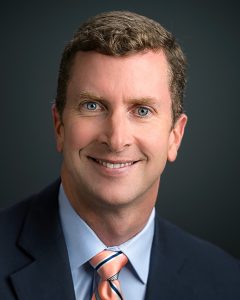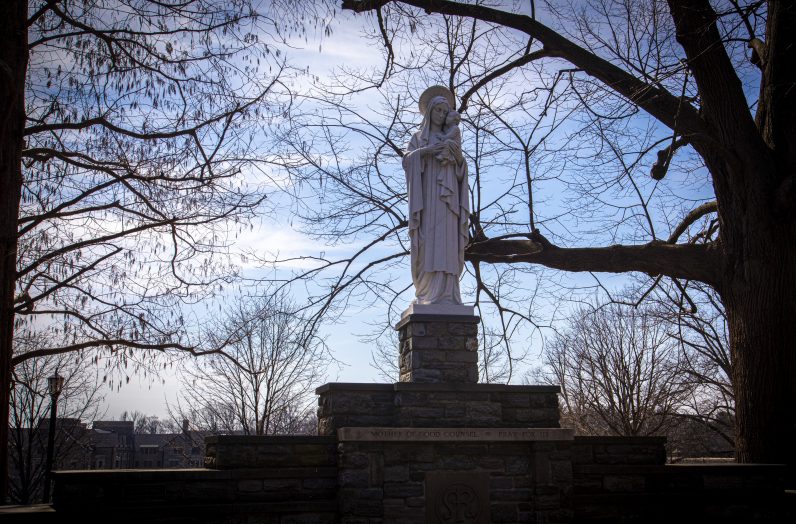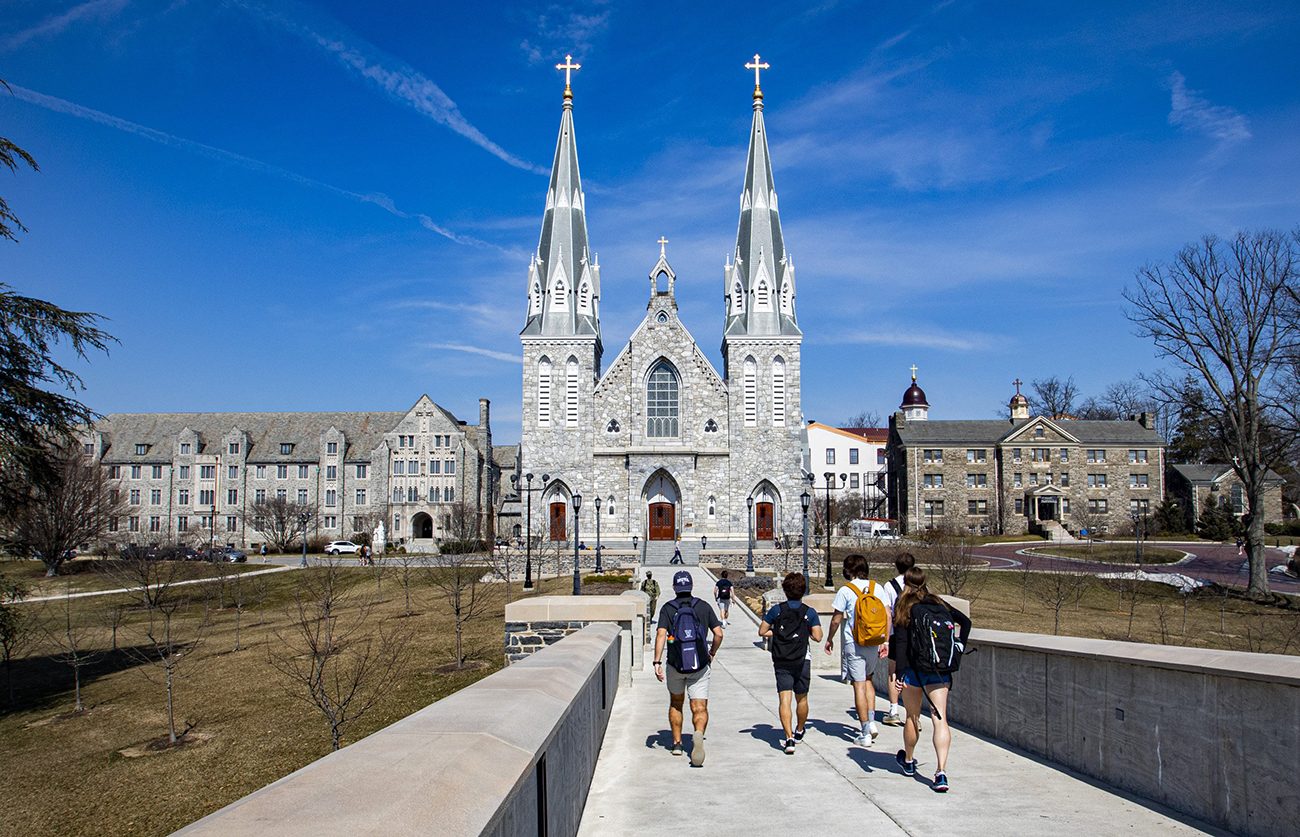WASHINGTON (CNS) — The churchgoing experience may be different once the threat of COVID-19 is minimized and church experts are forecasting fewer Catholics overall in the pews.
Fewer people attending church will require a radical restructuring of parish life in many parts of the U.S. in the post-pandemic era, said Matthew F. Manion, faculty director of the Center for Church Management at Villanova University near Philadelphia.
“From what I’m seeing, the pandemic speeds along processes that were already happening,” said Timothy P. O’Malley, a theology professor at the McGrath Institute for Church Life at the University of Notre Dame in Indiana. “The crisis that we’re going to experience in parishes is the rise of the nones (people who don’t identify with any religious affiliation). There is a sense of sort of a lost generation.”
[hotblock]
The people who were going through the motions of attending church basically out of obligation — but not out of a real love for the religion — dropped off during lockdowns when the churches were closed to Mass and many of them didn’t return once the churches reopened, O’Malley told Catholic News Service.
“I think the pandemic has clearly been an accelerant of changes and trends that were happening in the church already,” Manion said.
By studying data from several dioceses and archdioceses throughout the U.S., the Center for Church Management had projected — before the onset of the pandemic — that church attendance in 2030 would be half of what it had been in 2010, Manion told CNS.
“I think what the pandemic has done has brought that window way forward,” he said. “It’s not going to be 2030. It could be 2022, 2023.”

Matthew F. Manion, faculty director for the Center for Church Management at the Villanova School of Business near Philadelphia, is seen in this 2020 photo. (CNS photo/courtesy Villanova University)
Manion expects to see a sweeping parish shake-up in the U.S. post-pandemic to deal with fewer people in the pews.
“We are built for a church that no longer exists,” he said, “and we have an infrastructure for a church that no longer exists. An infrastructure that can no longer be supported in many cases.”
Hard decisions will have to be made, including parish merging and closures, Manion said.
A smaller and more humble church isn’t necessarily a bad outcome for this moment in Catholic Church history, said Massimo Faggioli, professor of historical theology at Villanova University.
It gives the people in church communities the opportunity to enrich their faith in the Gospel, find new ways to worship and ultimately employ better methods of evangelization to help their parishes flourish, Faggioli told CNS.
“We’re going to need a new approach to formation,” O’Malley said. “We’re going to need lay folk who are doing outreach, who are trained theologically and spiritually to do this kind of outreach within the parish, talk to their neighbors, be involved in conversations.
“We just can’t presume a sort of model where (the priest) stays in the parish, teaches and does catechesis,” O’Malley said. “It’s going to require a renewal of lay Catholic life.”
[hotblock2]
During the pandemic priests, women religious, members of parish councils and other members of the laity pulled together to try and reach Catholics through the use of technology while communities were in lockdown, said Bishop Michael F. Burbidge of Arlington, Virginia.
More Masses were livestreamed, parish council members collaborated via Zoom video conference and the creative spirit began with the production of catechetical videos for people stuck at home with more time on their hands, which helped engage people in the faith, Bishop Burbidge said.
“What we began to see is, ‘Guess what we’re doing? We’re evangelizing,'” he said.
There was a missionary approach to religion in the early days of the pandemic that took priests and religious out of the rectories and into the communities to offer COVID-19-safe confessions, outdoor Mass, eucharistic adoration and community lay-led prayer groups.
When Marie Miller attended Mass in the parking lot of St. Thomas More Catholic Church in Allentown, Pennsylvania, last October, she marveled at the creativity of her parish in providing a pandemic-safe liturgy and she really liked worshipping outside in the fresh air.
[tower]
“I hope they keep something like this after this whole coronavirus pandemic is behind us,” she told CNS. “I hope they at least continue to give us an opportunity to attend Mass outside. I feel closer to God out here.”
It currently requires a dispensation from a local bishop to authorize a Mass outside, something that was done generously during the pandemic to provide safe worship spaces.
Faggioli believes church leaders will be looking at more use of outdoor worship in the post-pandemic era, because people like Miller discovered a greater sense of her Creator while attending Mass outside.
“What we saw from this church during the pandemic was a church that attempted every method they could think of to keep people faithful to the Gospel,” he said. “Some of it worked and some of it didn’t. I’m hoping you’re going to see that same kind of creativity and transformation in how we do church in the future. If the pandemic is any gauge, it shows the will is there.”
It’s likely that more lay-led catechesis, devotions, prayer life and evangelization will emerge with less reliance on the clergy, O’Malley said.
“We should be doing more outside and in our neighborhoods and the laity can help lead devotional life,” he said. “I’d love to see more outdoor processions and outdoor visible participation in religious life.”
There can be more participation in the digital space as well, such as group catechesis and even a monthly Zoom meeting with a bishop, which may be a more practical way of faith involvement, O’Malley said.
The pandemic brought an openness to try new things, which can bring necessary reforms to the post-pandemic church, Manion said.
“I hope that we don’t immediately go back to ‘OK, good, we survived, let’s go back to the way everything was,” he said with a laugh. “I hope we take the things that were good from before and the things that were good that were learned through this (pandemic) to continue to spark new ways of doing things.”

A statue of Mary can be seen in a grotto at Villanova University near Philadelphia March 11, 2021. (CNS photo/Chaz Muth)
PREVIOUS: Virginia bishops say allowing unlimited abortion is ‘deplorable policy’
NEXT: Jesuits pledge $100 million to benefit descendants of enslaved people




Share this story